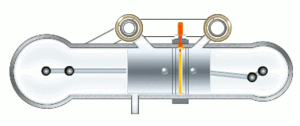What is DTSi?
The DTSi (Digital Twin Spark ignition) technology from Bajaj could potentially revolutionise motorcycling in the country. The company may well want to replicate the technology in its other engines as well. This technology, which is also being patented by Bajaj Auto, boosts the performance of the engine, while simultaneously cutting emissions.
The DTSi technology incorporates twin sparkplugs at either ends of the combustion chamber for faster and better combustion. Single sparkplug meant slower burning of the air-fuel mixture and sub-optimal combustion chamber characteristics. This is the heart of the new technology from Bajaj. But, its benefits are fully realised only after it is combined with a computerised direct ignition (CDI) system and new generation throttle response system.
The digital CDI in the new Pulsar, which features an advanced eight-bit microprocessor handles the spark delivery. The programmed chip's memory contains the optimum ignition timing for any given engine rpm, thereby squeezing out the best performance characteristics from the combustion chamber. Working together with the Throttle Responsive Ignition Control System (TRICS III) supposedly also delivers the optimum ignition timing for varying load conditions.
Bajaj has also developed a new third generation TRICS III to complement the new ignition system. The TRICS system controls the ignition based on throttle use. Depending on the needs of the motorcycle rider, whether for cruising or a burst of acceleration (such as for overtaking), the ignition requirements changes; especially useful in city riding conditions.
Based on the level of throttle opened, a magnetic field opens or closes the reed switch, which, in turn, is connected to the Digital CDI. The CDI then switches to the desired Ignition Advance Timing Maps (pre-programmed timing from the eight-bit processor). This helps the engine achieve an ideal ignition spark advance for every throttle opening and engine rpm level.
Current motorcycle and scooter engines have a single spark plug that ignites the air and fuel mixture inside the combustion chamber. As a result, the rectangular combustion chambers in most motorcycle engines have a certain degree of unburnt air-fuel mix, since the flame front arising from the sparkplug does not reach all the corners of the combustion chamber.
This loss of unburnt air-fuel mix leads to lower power and fuel efficiency. After Bajaj Auto perfected the technology for adding a second spark plug to the engine and the engine management systems to go with it, it decided to first put the new technology to work on the Pulsar.
What is ExhausTEC?
ExhausTEC stands for Exhaust Torque Expansion Chamber, a technology patented by Bajaj.
The technology involves use of a small chamber connected to the exhaust pipe of the engine to modify the back-pressure and the swirl characteristics, with an aim to improve the low-end performance of the bikes.
The ExhausTEC technology is claimed to be highly effective in improving the low- and mid-range torque.
What does this Torque Expansion Chamber do?
We should first have an idea of what “Torque” is and what it does to a motorcycle.
Torque is the “twisting force” that rotates the wheels of a motorcycle.
It is torque which is responsible for moving/accelerating at slow speeds. More torque at slow speeds means that acceleration or pick up at slow speed will be good.
The Torque Expansion Chamber (TEC) improves the scavenging (exit process) of the exhaust gases and is also designed create a pressure difference inside the exhaust pipe. This pressure difference inside the exhaust pipe creates a vacuum which helps to pull in additional air-fuel mixture at low engine speeds and thus improves the engine torque at low revs without compromising the mid or high engine revs.
The benefit of the feature is that good pick up is available right down from slow engine speeds and therefore there is less need for changing gears in stop-go traffic conditions.
 The theory behind anti-lock brakes is simple. A skidding wheel (where the tire contact patch is sliding relative to the road) has less traction than a non-skidding wheel. If you have been stuck on ice, you know that if your wheels are spinning you have no traction. This is because the contact patch is sliding relative to the ice (seeBrakes: How Friction Works for more). By keeping the wheels from skidding while you slow down, anti-lock brakes benefit you in two ways: You'll stop faster, and you'll be able tosteer while you stop.
The theory behind anti-lock brakes is simple. A skidding wheel (where the tire contact patch is sliding relative to the road) has less traction than a non-skidding wheel. If you have been stuck on ice, you know that if your wheels are spinning you have no traction. This is because the contact patch is sliding relative to the ice (seeBrakes: How Friction Works for more). By keeping the wheels from skidding while you slow down, anti-lock brakes benefit you in two ways: You'll stop faster, and you'll be able tosteer while you stop.
















